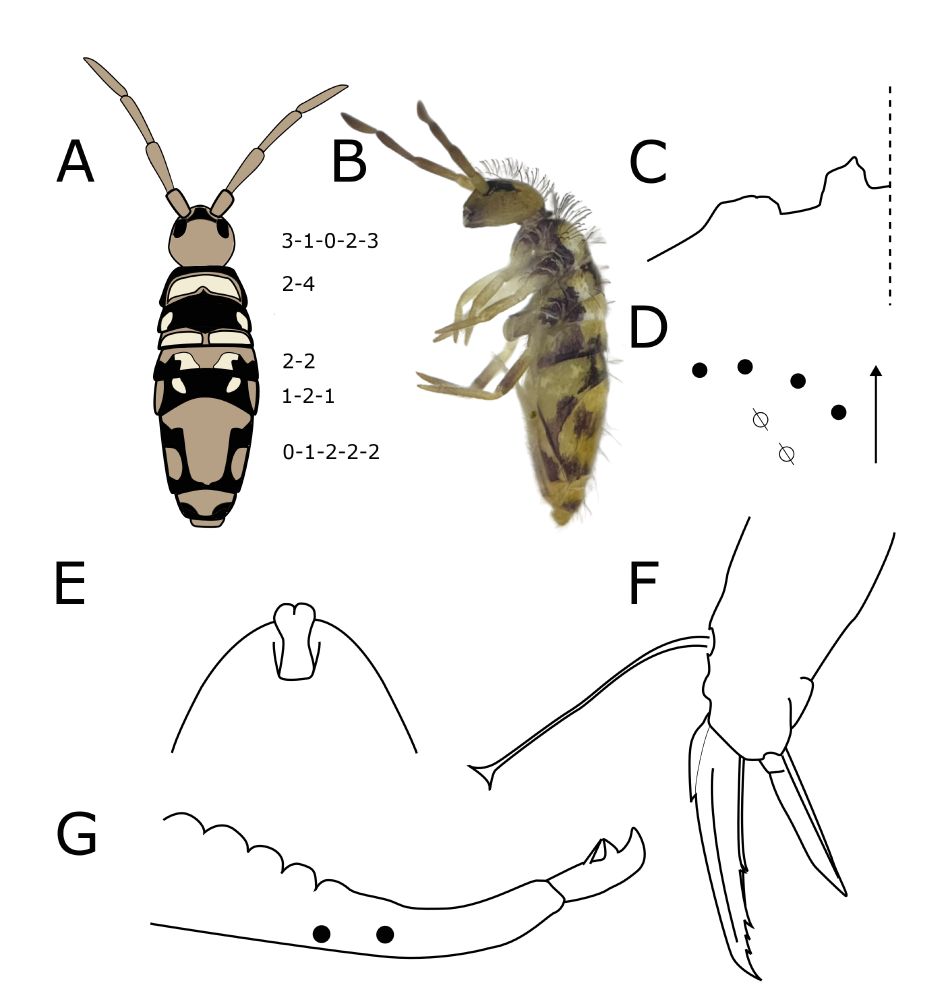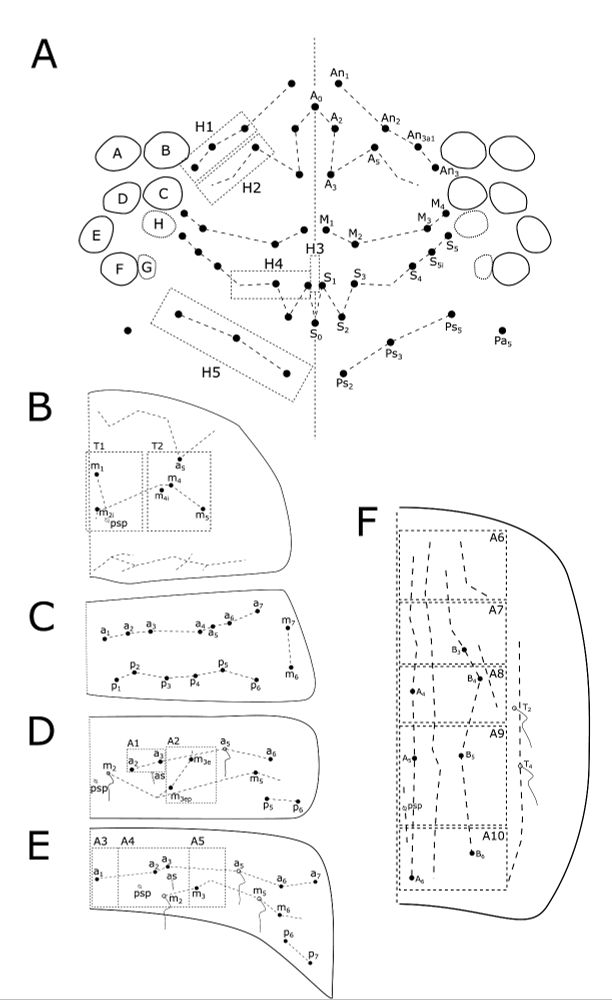
James McCulloch
@jamesimcc.bsky.social
PhD student in genomics at the Wellcome Sanger Institute/University of Cambridge. National recorder for springtails. Evolutionary biology, entomology, taxonomy, natural history...
https://www.sanger.ac.uk/person/mcculloch-james/
https://www.sanger.ac.uk/person/mcculloch-james/
A photo from the side would help if possible!
Regarding the mouthparts, my technique is usually to clear the specimen using NaOH or KOH, and then squash under a coverslip. Usually then, if the specimen is cleared well enough, you can see the mouthparts through the head without any fiddly work!
Regarding the mouthparts, my technique is usually to clear the specimen using NaOH or KOH, and then squash under a coverslip. Usually then, if the specimen is cleared well enough, you can see the mouthparts through the head without any fiddly work!
November 4, 2025 at 9:41 AM
A photo from the side would help if possible!
Regarding the mouthparts, my technique is usually to clear the specimen using NaOH or KOH, and then squash under a coverslip. Usually then, if the specimen is cleared well enough, you can see the mouthparts through the head without any fiddly work!
Regarding the mouthparts, my technique is usually to clear the specimen using NaOH or KOH, and then squash under a coverslip. Usually then, if the specimen is cleared well enough, you can see the mouthparts through the head without any fiddly work!
You're certainly right that this is in the Hypogastrura/Ceratophysella group! With small anal spines it'll be Hypogastrura, but I'm not 100% confident that the shape of the mucro is definitely manubrialis - it can be hard to judge depending on angle, but in photo 4 it looks a little broader
November 4, 2025 at 9:40 AM
You're certainly right that this is in the Hypogastrura/Ceratophysella group! With small anal spines it'll be Hypogastrura, but I'm not 100% confident that the shape of the mucro is definitely manubrialis - it can be hard to judge depending on angle, but in photo 4 it looks a little broader
(S. trinotatus has these setae, while bimaculatus does not)
August 24, 2025 at 7:29 PM
(S. trinotatus has these setae, while bimaculatus does not)
Finding hyper-specific details like this to back up an identification never fails to make me smile!
August 24, 2025 at 2:59 PM
Finding hyper-specific details like this to back up an identification never fails to make me smile!
I will finish by sharing this beautiful and romantic video of Sminthurides courtship. One of my favourite things!
www.youtube.com/watch?v=p7IV...
🧵7/7
www.youtube.com/watch?v=p7IV...
🧵7/7

Weiße Wasserkugelspringer (Sminthurides aquaticus) beim Paarungsritual 💕
YouTube video by Dominik Grimm
www.youtube.com
August 24, 2025 at 2:40 PM
I will finish by sharing this beautiful and romantic video of Sminthurides courtship. One of my favourite things!
www.youtube.com/watch?v=p7IV...
🧵7/7
www.youtube.com/watch?v=p7IV...
🧵7/7
Finally, this is the tiny Sminthurides bifidus. These are synanthropic aquatic springtails found on the edge of glasshouse water features and fish tanks. The dorsal black marking is quite variable.
The males are smaller and have antennal clasping organs to grasp the females in courtship! 🧵6/7
The males are smaller and have antennal clasping organs to grasp the females in courtship! 🧵6/7

August 24, 2025 at 2:40 PM
Finally, this is the tiny Sminthurides bifidus. These are synanthropic aquatic springtails found on the edge of glasshouse water features and fish tanks. The dorsal black marking is quite variable.
The males are smaller and have antennal clasping organs to grasp the females in courtship! 🧵6/7
The males are smaller and have antennal clasping organs to grasp the females in courtship! 🧵6/7
This is Seira domestica, a slender springtail almost never found outdoors (in the UK, at least). Lepidocyrtus have similar iridescent scales but have 2 teeth on the mucro (furca apex), not 1.
When assembled, this will be the first reference-quality genome from the subfamily Seirinae! 🧵5/7
When assembled, this will be the first reference-quality genome from the subfamily Seirinae! 🧵5/7


August 24, 2025 at 2:40 PM
This is Seira domestica, a slender springtail almost never found outdoors (in the UK, at least). Lepidocyrtus have similar iridescent scales but have 2 teeth on the mucro (furca apex), not 1.
When assembled, this will be the first reference-quality genome from the subfamily Seirinae! 🧵5/7
When assembled, this will be the first reference-quality genome from the subfamily Seirinae! 🧵5/7
This is Sminthurinus igniceps, a relative but less distinctive. It can be told from dark S. aureus by having a head paler than the body, and from S. domesticus by having mostly orangey antennae.
This species is also synanthropic, but seemingly moving out more into the wider countryside. 🧵4/7
This species is also synanthropic, but seemingly moving out more into the wider countryside. 🧵4/7

August 24, 2025 at 2:40 PM
This is Sminthurinus igniceps, a relative but less distinctive. It can be told from dark S. aureus by having a head paler than the body, and from S. domesticus by having mostly orangey antennae.
This species is also synanthropic, but seemingly moving out more into the wider countryside. 🧵4/7
This species is also synanthropic, but seemingly moving out more into the wider countryside. 🧵4/7
Despite its spots which seem to glow among the woodchips, S. bimaculatus is very similar to S. trinotatus. You need to look for a pair of hairs called subapical ventral setae on the dens, part of the springing organ (furca) that gives springtails their name. This arrow shows where they'd be! 🧵3/7

August 24, 2025 at 2:40 PM
Despite its spots which seem to glow among the woodchips, S. bimaculatus is very similar to S. trinotatus. You need to look for a pair of hairs called subapical ventral setae on the dens, part of the springing organ (furca) that gives springtails their name. This arrow shows where they'd be! 🧵3/7
This beautiful species, Sminthurinus bimaculatus, has been the British springtail I've most wanted to see. As with the other 3 spp., it's primarily synanthropic, meaning it's associated with human habitats like this flowerpot. 🧵2/7


August 24, 2025 at 2:40 PM
This beautiful species, Sminthurinus bimaculatus, has been the British springtail I've most wanted to see. As with the other 3 spp., it's primarily synanthropic, meaning it's associated with human habitats like this flowerpot. 🧵2/7
Yes, sorry for the delay!
August 15, 2025 at 1:12 PM
Yes, sorry for the delay!
While the data are thin for signata and flavosignata, it’s the case that minuta, saundersi & ornata can be found under the same log. Despite apparent morphological identicalness, there could be other reasons they don’t outcompete each other, e.g. physiological/metabolic adaptations to different food
July 23, 2025 at 6:39 AM
While the data are thin for signata and flavosignata, it’s the case that minuta, saundersi & ornata can be found under the same log. Despite apparent morphological identicalness, there could be other reasons they don’t outcompete each other, e.g. physiological/metabolic adaptations to different food
That's exciting! I'm on the look out for springtail samples from across the world for a future project - I'll direct message you!
July 17, 2025 at 12:13 PM
That's exciting! I'm on the look out for springtail samples from across the world for a future project - I'll direct message you!
Now that we have a name for this springtail, it is much easier for us to monitor its spread, analyse its interaction with the ecosystem, identify its origins, and study its populations & evolution through the lens of genomics.
Read the full description here: soil-organisms.org/index.php/SO...
Read the full description here: soil-organisms.org/index.php/SO...
View of Entomobrya petri sp. nov.: A new species of springtail found in the British Isles
soil-organisms.org
July 16, 2025 at 2:07 PM
Now that we have a name for this springtail, it is much easier for us to monitor its spread, analyse its interaction with the ecosystem, identify its origins, and study its populations & evolution through the lens of genomics.
Read the full description here: soil-organisms.org/index.php/SO...
Read the full description here: soil-organisms.org/index.php/SO...
A huge thank you to @persmiseth.bsky.social for showing me a population of these springtails when I was visiting Edinburgh earlier this year; some of them then became the type specimens. Also, Alex McDermott-Roberts and @jaiiiiiii1.bsky.social for providing specimens/photos from elsewhere.
July 16, 2025 at 2:07 PM
A huge thank you to @persmiseth.bsky.social for showing me a population of these springtails when I was visiting Edinburgh earlier this year; some of them then became the type specimens. Also, Alex McDermott-Roberts and @jaiiiiiii1.bsky.social for providing specimens/photos from elsewhere.
While it appears similar to true E. imitabilis, described from a single Chinese specimen, the pattern of E. petri is unique. The chaetotaxy - the arrangement of hairs (setae) on different parts of the body - is also unique.
Click the Alt text on these images for explanations of what they depict!
Click the Alt text on these images for explanations of what they depict!


July 16, 2025 at 2:07 PM
While it appears similar to true E. imitabilis, described from a single Chinese specimen, the pattern of E. petri is unique. The chaetotaxy - the arrangement of hairs (setae) on different parts of the body - is also unique.
Click the Alt text on these images for explanations of what they depict!
Click the Alt text on these images for explanations of what they depict!
Formerly known as Entomobrya nr imitabilis, this morphospecies was first spotted in 2015. Since then it has appeared across the whole length of the British Isles - the type specimens were found on an Edinburgh gravestone. Where it has come from and how it has spread so quickly is a mystery...

July 16, 2025 at 2:07 PM
Formerly known as Entomobrya nr imitabilis, this morphospecies was first spotted in 2015. Since then it has appeared across the whole length of the British Isles - the type specimens were found on an Edinburgh gravestone. Where it has come from and how it has spread so quickly is a mystery...
That would be very useful - it'd be ideal to make sure I'm not missing any records! Thanks!
July 15, 2025 at 3:06 PM
That would be very useful - it'd be ideal to make sure I'm not missing any records! Thanks!

